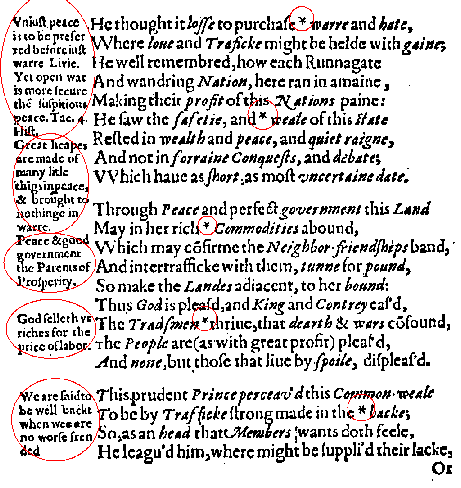UMI ID #13152386
STC WING F408
AUTHOR: Fane, Francis, Sir, d. 1689?
TITLE: Love in the dark, or, The man of bus'ness
Page 9 (Image 9)
Q: Do we treat the text marked by the curly brace as a <NOTE> for the two lines? If so, do we enter it after the second line?

A: This is the special kind of note called a <STAGE>, i.e. a stage direction. So it should be tagged as <STAGE>.
As to where to put it, I think the braces here are confusing. The safest thing to do in this case is probably to put it where you suggest, at the end of the second line, but at the end of the previous line would make as much sense. Either would work.
Tuck the <STAGE> tag inside the end of the <L> tag, just as you would if it were a <NOTE>. IN fact, the guidelines for the placement of <NOTE>s are pretty safe guides for the placement of <STAGE> directions too, except that <STAGE>s are much more likely than <NOTE>s to belong exactly where they are found.
The other <STAGE> elements found on IMG 9 (pp.8-9) should be placed where they appear, i.e., as follows. (note the use of <HI> to mark text set off from the italic that seems to be the dominant face in the stage directions:
p.8
... when confest.<STAGE>Exit.</STAGE></L>
... too much company.<STAGE>Exit.</STAGE></L></SP>
<STAGE>The <HI>SCENE Cornanti's</HI>House.</STAGE>
<STAGE>Enter <HI>Bellinganna</HI> and <HI>Vigilia</HI></STAGE>
<SP><SPEAKER>Bell.</SPEAKER> ...
... at liberty.</L></SP>
<STAGE>Enter <HI>Cornanti</HI>furiously.</STAGE>
<SP><SPEAKER>Cor.</SPEAKER>...
... for thy next offence.<STAGE>Shews his Dagger.</STAGE></L>
p.9
.. to keep from Weeds.</L>
<STAGE>Exeunt <HI>Bell.</HI> and <HI>Vigil.</HI>the door shut upon them</STAGE>
<STAGE>Knocking without. Enter <HI>Scrutinio</HI> the Confessor.</STAGE>
<L>Oh, here comes ...
... some years yet.<STAGE>Aside.</STAGE></L>
UMI ID #99844994
STC STC6333
AUTHOR: Davies, John, 1565?-1618.
TITLE: Microcosmos.
Page 152 (Image 85)
Q: There are asterisks within the text that seem to be references, but there are no corresponding notes. Should we capture these as ordinary text ("*")?

A: It looks to me as though this book uses a variety of means to make sure that notes get attached to the right point in the text:
(1) sometimes, as on p. 154 (image 86), the notes are short and can be placed more-or-less next to the right spot in the text.
(2) sometimes, as on p. 153 (image 85), the notes are long and many, and are attached by means of sequential reference letters (a, b, c, etc.). And
(3) sometimes, as on this page (p. 152, image 85), the notes are long enough that they can't easily be placed right next to the right spot, but there aren't so many that they need letters. Instead, the place of each note is marked with an asterisk; the reader is expected to link the first note with the first asterisk, the second note with the second asterisk, and so on down to the fifth note, which belongs at the spot marked by the fifth asterisk.
So these are, I think, really note markers. The five corresponding notes in the margin begin as follows:
1st *: Vniust peace is ...
2nd *: Great heapes are made ...
3rd *: Peace & good government ...
4th *: God selleth vs riches ...
5th *: We are said to be well backt ...
